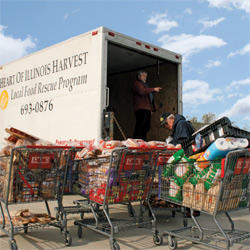
Don’t let high fuel and maintenance costs cripple a bountiful harvest.
Nearly 60 tons of edible food goes to the landfill each day, says Heart of Illinois Harvest co-founder Bill Lervaag. “We try to pick up as much as we can.” But vehicle maintenance and high fuel costs could cripple the distribution of the surplus food that the rescue organization picks up and delivers to hungry Peorians each week.
Heart of Illinois Harvest (HOIH) was founded in December of 1992 by the late Hobe Albright, Robert Baietto, the late Gene Slevin, Greg Howerton, Dennis Brown, Bill Lervaag and Ted Kern, after learning about the Harvest program in Louisville, Kentucky. It was the first Harvest chapter in the state of Illinois and the 52nd chapter nationwide.
Just a month after its formation, a truck carrying 42,000 pounds of potatoes to a potato chip factory in North Carolina broke down on I-74. The factory would not take the potatoes because the temperature had risen above 45 degrees, so the transfer company contacted the newly formed Heart of Illinois Harvest. The semi trailer containing the potatoes was towed to a parking lot in Peoria, and people lined up for blocks to get the free spuds. All 42,000 pounds disappeared in just four hours.
Initially, Kroger stores were the primary donors of surplus food to HOIH. Today, 44 different donors supply the organization with more than six tons of food each week to deliver to 53 area groups, including various church food pantries, the Salvation Army, Peoria Rescue Mission, South Side Mission and Children’s Home. In the first quarter of 2011, food donations have increased to a consistent 7.25 tons per week.
In light of the recent recession, there has been a large jump in the number of Peoria-area citizens who go hungry, and thus an increased demand for the services of Heart of Illinois Harvest. Its mission is to decrease those numbers. “We never buy food, and we never deliver to resellers,” says Lervaag. “We figured that for every $1 donated, 40 meals could be served.” Not just anyone can receive food from HOIH. No deliveries are made to private homes, and requesting organizations are screened before any deliveries are made to ensure that they are nonprofit and will not resell the food.
Food pick-ups and deliveries have increased about 35 percent from last year, and HOIH is always accepting additional donors. Hy-Vee, Schnuck’s, Kroger and other grocers are on the route every day. Other donors, like Panera, contribute several days a week. Routes are coordinated with set pick-up and delivery times, but those can change if a call into the office indicates a new pick-up or delivery for that day. In addition to its own operations, HOIH works with the Midwest Food Bank to distribute large quantities of food across the area.
To help keep operational costs low, HOIH has just a single, part-time, paid employee. About 60 volunteers, whose average age is 72, load, drive and deliver the food each day, to recipients. “All of our volunteers are also donors,” notes HOIH Board Chairman Jay Buehler.
A variety of in-kind services from area businesses cover some of the basic operating costs, but the recent increase in fuel prices, insurance and maintenance for its delivery vehicles are huge obstacles for the organization. Individual donations are always appreciated, and HOIH continually applies for grant money to help support its mission. “This organization runs on fuel and money,” adds Buehler. And they need more of both to ensure that Peoria doesn’t go hungry. Visit hoiharvest.org to find out how you can make a difference.

